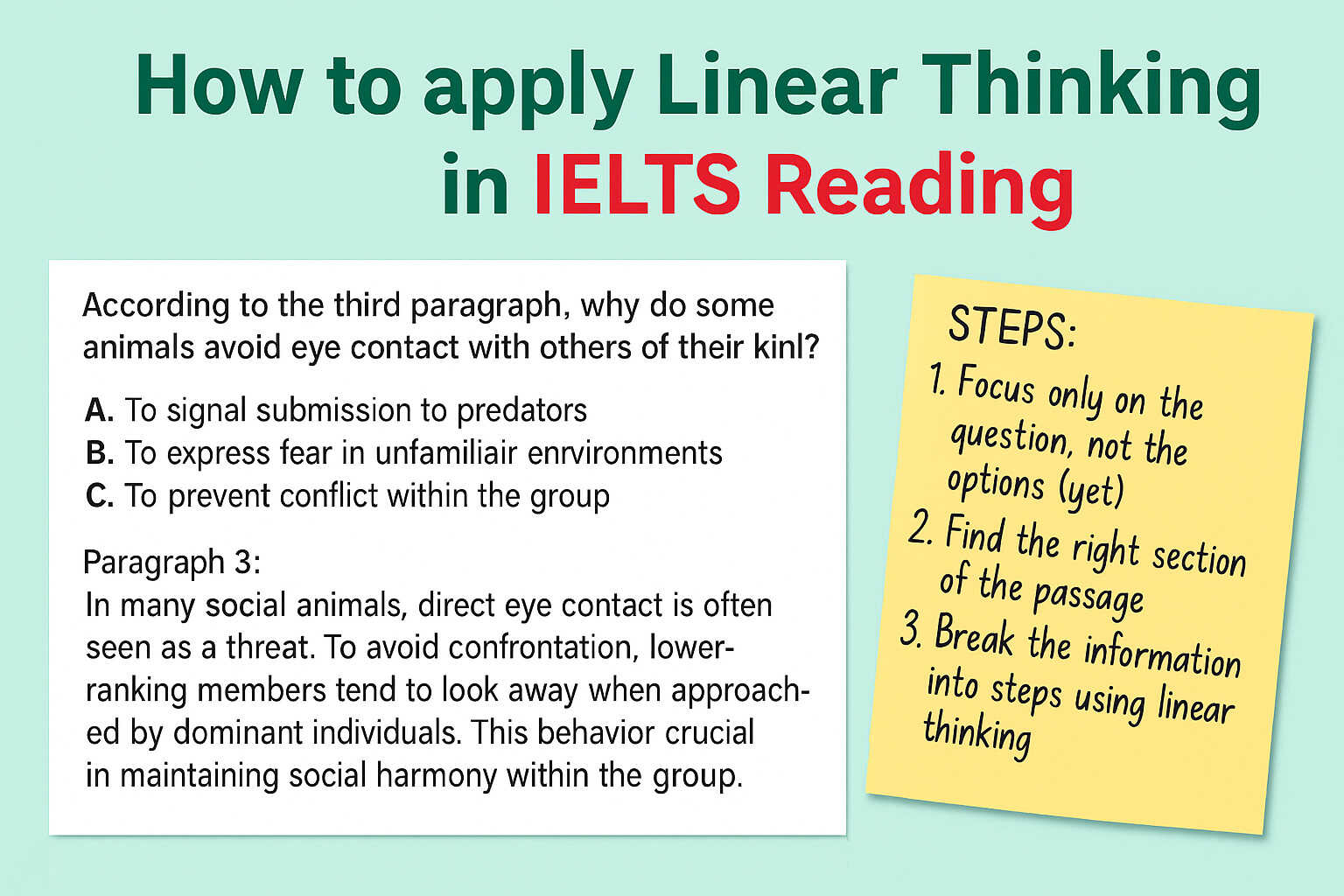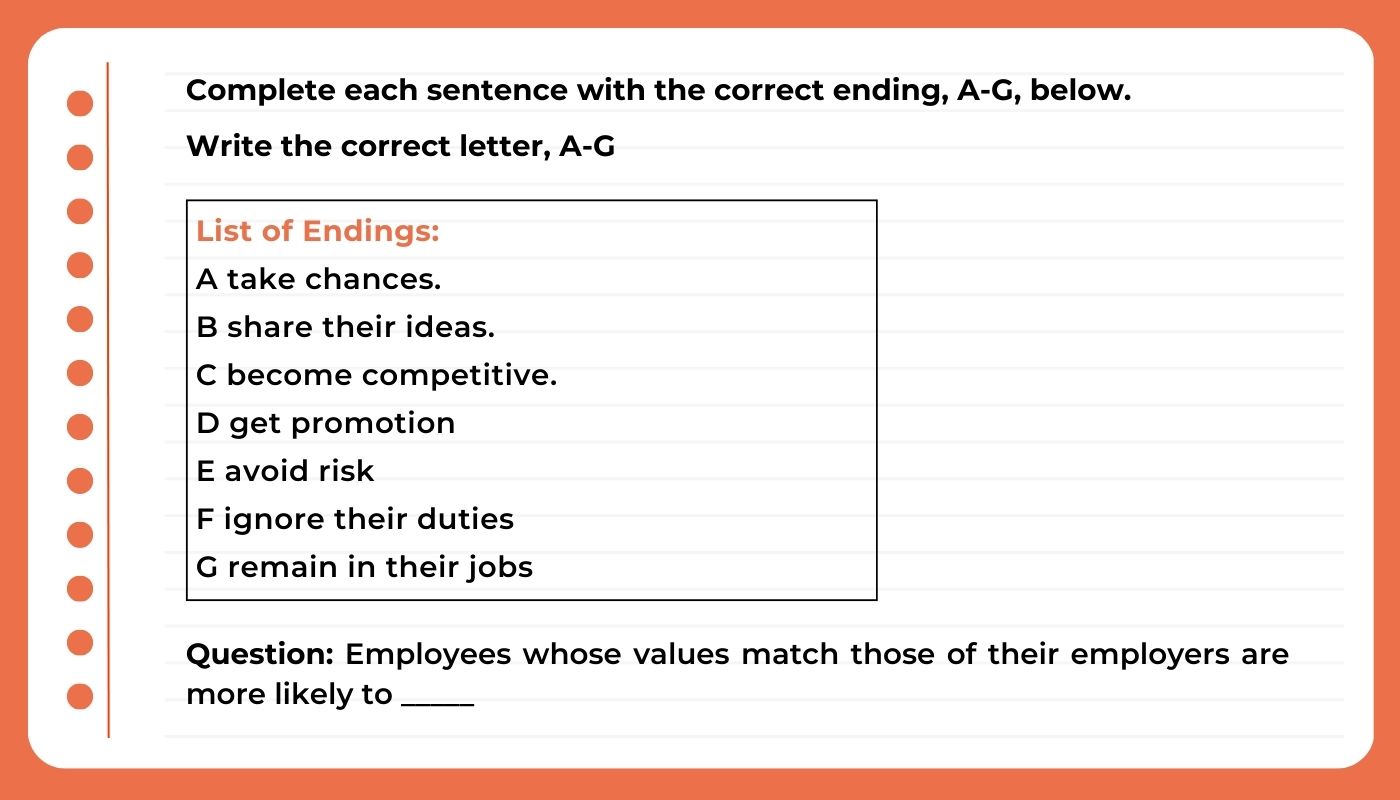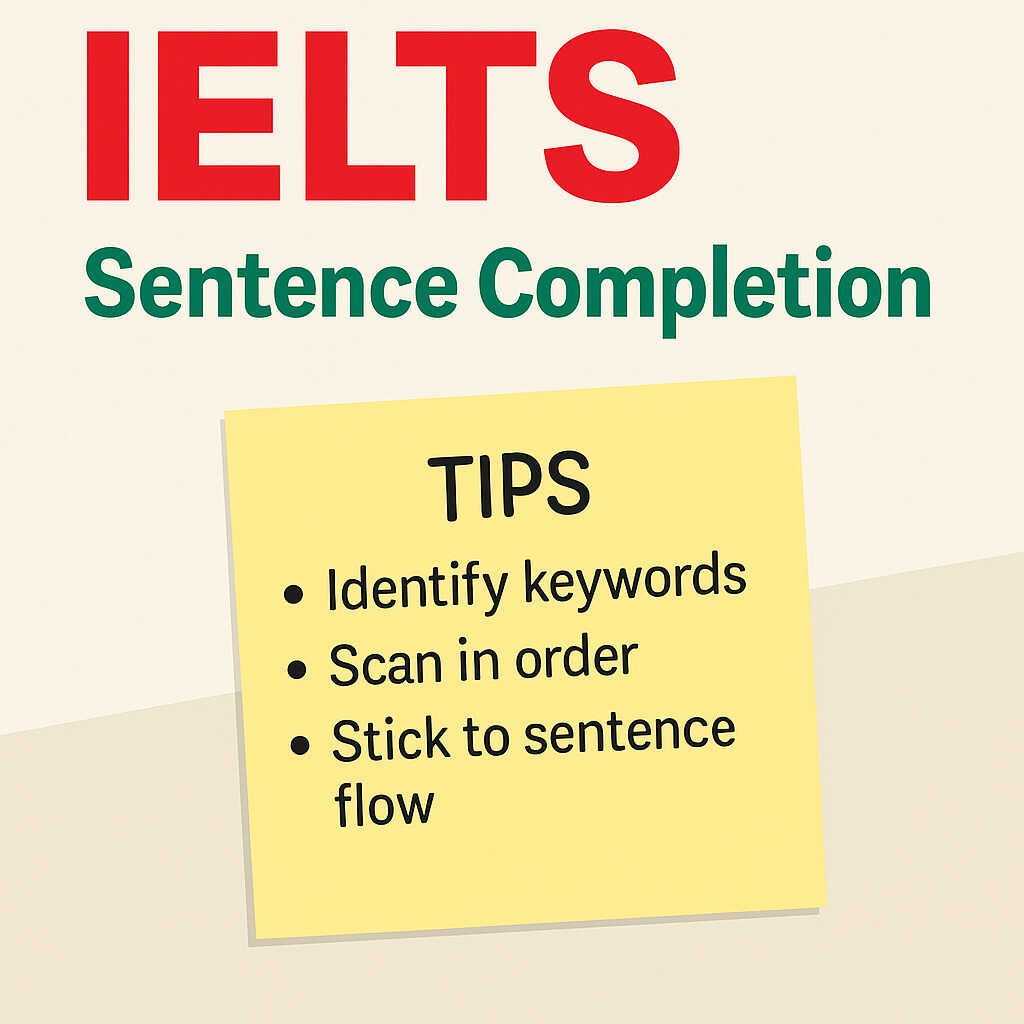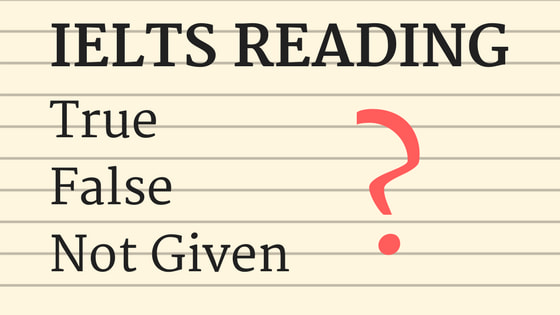What Is Linear Thinking? How to Apply to the IELTS Reading
Ever find yourself reading an IELTS passage and thinking, “Where do I even begin?” If that sounds familiar, you might be missing one key approach: linear thinking. Linear thinking is a strategy that helps you move through complex texts in a step-by-step way. When applied effectively, it can turn even the trickiest IELTS Reading questions into a more manageable task.
In this blog, we’ll break down what linear thinking is, and more importantly, how you can apply it to improve your IELTS Reading performance. Let’s scroll down!
What Is Linear Thinking?
If you ever wonder “What is linear thinking”, the best answer is: This is an approach to problem-solving where information flows in a clear, logical order. It involves breaking down complex ideas into manageable steps and addressing one point at a time. In short, it is a focused way of thinking that allows you to move from point A to point B without distractions.

So, what makes this way of thinking stand out? Here’s a quick look at its key characteristics:
- You process information step by step, rather than all at once
- You follow a logical chain of reasoning, where one point leads naturally to the next
- You prefer to analyze ideas in the exact order they appear, not by skipping around
Now, to truly appreciate the value of linear thinking, it’s useful to compare it to non-linear thinking, which operates quite differently. Here’s the two compare side by side:
| Linear Thinking | Non-linear Thinking |
| Follows a clear, structured path | Jumps between ideas and connections |
| Sequential in nature, one idea leads to the next | Makes creative leaps and connects ideas in unexpected ways |
| Great for tasks with step-by-step solutions | Ideal for open-ended or abstract thinking |
So, what is the main difference between linear and nonlinear? Indeed, linear thinking is all about following a clear sequence, while non-linear thinking thrives on flexibility. Both are useful, but for tasks like IELTS Reading, linear thinking often helps you stay on track and find answers efficiently.
How to apply Linear Thinking in IELTS Reading
1. Multiple Choice Questions (MCQ)

First of all, linear thinking is highly effective for solving multiple-choice questions in IELTS Reading, since these questions often follow the order of the passage. To apply this approach correctly, follow these steps:
- Step 1: Focus only on the question, not the options (yet)
Suppose the question is:
According to the third paragraph, why do some animals avoid eye contact with others of their kind?
At this point, ignore A, B, C, and D. Your goal is to understand:
- Which paragraph to read (paragraph 3)
- What to look for (the reason animals avoid eye contact)
- Step 2: Find the right section of the passage
Go to paragraph 3. Let’s say it reads:
In many social animals, direct eye contact is often seen as a threat. To avoid confrontation, lower-ranking members tend to look away when approached by dominant individuals. This behavior is crucial in maintaining social harmony within the group.
Now that you’ve found the section, apply linear reading: follow the sentences in order.
- Step 3: Break the information into steps using linear thinking
Simplify what the text says:
- Eye contact → seen as a threat
- Lower-ranking animals → avoid it
- Purpose → avoid conflict / maintain harmony
Main idea: Avoiding eye contact = a way to prevent aggression and keep peace
- Step 4: Now go back and evaluate the answer choices
Let’s say the options are:
- To signal submission to predators
B. To express fear in unfamiliar environments
C. To prevent conflict within the group
D. To protect themselves from physical harm
Compare each one with your simplified takeaway. C is the most accurate match. Others either distort the context or mention ideas not found in the paragraph.
With linear thinking, you can stay focused, narrow down the options, and avoid unnecessary confusion.
Read more: IELTS Reading Multiple Choice Questions
2. Matching Headings

Unfortunately, linear thinking is not always effective for matching headings, as the headings may not follow the passage’s order. Instead, this task requires nonlinear skills, such as summarizing, to focus on the overall theme of the paragraph rather than just its order in the text.
To succeed in this task, keep these tips in mind:
- Skim the entire paragraph first to get a sense of its main idea.
- Focus on keywords rather than getting stuck on specific details.
- Don’t rush to choose
Read more: IELTS Reading Matching Heading Questions
3. Matching Information

Like the previous task, matching information also doesn’t benefit much from linear thinking, as information could appear anywhere. You need to rely on non-linear skills like identifying keywords and recognizing paraphrases to find the correct matches.
To approach this task effectively, try the following:
- Read all the options first: Understand what information you need to look for.
Focus on keywords: Scan the entire text, looking for words or phrases that match the options. - Use paraphrasing: The correct information might be rephrased, so look for the meaning rather than the exact wording.
Read more: IELTS Reading Matching Information Questions
4. Matching Features

When answering matching features, linear thinking helps you stay organized by focusing on each paragraph as it comes. This is especially useful when features are described in order, like person by person or object by object.
However, since the answers may not always follow the passage’s sequence, you’ll need some flexibility as well. To tackle this:
- Step 1: Read all the options first
For example, the question is:
Which person: A, B, C, or D?
(i) believes that environmental laws are ineffective
(ii) highlights the role of local communities in conservation…*
Before you read the passage, get familiar with what you’re matching—names and opinions. This will help you recognize relevant info when you see it.
- Step 2: Go paragraph by paragraph, one feature at a time
Let’s say paragraph 2 is about “Dr. Lee,” and you read:
Dr. Lee argues that environmental policies often fail because they don’t account for real-world complexities.
Now apply linear thinking:
- Read through the paragraph from start to end.
- Identify the key idea: Dr. Lee thinks the laws don’t work as intended.
Now go back to your options. That clearly supports (i) – believes that environmental laws are ineffective → Dr. Lee.
- Step 3: Continue in order, track matches, and stay flexible
Go to the next paragraph, process it the same way. But don’t expect the order of the answers to match the text. Sometimes (ii) comes before (i) in the passage—that’s normal.
What matters is:
- You read one paragraph at a time
- You only match when the evidence is clear
- You rule out options as you go
Linear thinking keeps you methodical, while your awareness of non-linear answer order stops you from falling into traps. The combination of both is key for this question type.
5. Matching Sentence Endings

Another approach to consider is using linear thinking to match sentence endings. Look for clues in the first part of the sentence, then find the ending that fits naturally. This method lets you quickly identify the right connection from the beginning and ending of sentences.
Read more: IELTS Reading Matching Sentence Endings Questions
6. Sentence Completion

In sentence completion, the answers usually appear in the same order as the passage, which fits linear thinking well. To approach it effectively:
- Identify keywords in the incomplete sentence
- Scan the passage in order to find the matching idea
- Stick to the sentence flow
- Check grammar to make sure the completed sentence reads smoothly.
Read more: IELTS Reading Sentence Completion Questions
7. Summary Completion (with/without a box)

Summary completion strongly favors a linear approach, as the summary usually reflects the order of ideas in the passage. Here’s how to use that to your advantage:
- Use the summary as a guide and follow the order of the passage.
- Read step by step, focus on key ideas, and match them with the gaps.
- Watch for paraphrasing, and make sure each word fits both meaning and grammar.
In short, linear thinking keeps you on track and saves you from scanning aimlessly.
Read more: IELTS Reading Summary Completion Questions
8. Note/Table/Flow-chart Completion

Note, table, and flowchart completion tasks are built for linear thinking. The information in these questions often follows the same order as the passage, so reading step by step is the most efficient way to approach them.
Linear thinking in IELTS reading note/table/flowchart completion
Let’s say the task asks you to complete this table:
| Step | Action Taken |
| 1 | Select healthy seeds |
| 2 | ____________ |
| 3 | Dry seeds in the sunlight |
You go to the passage and find this section:
Farmers first select only the healthiest seeds from the previous harvest. They then soak them in warm water for 24 hours to encourage early germination. Once soaked, the seeds are spread out under direct sunlight to dry completely.
Using linear thinking:
- You follow the process in order, as it appears
- You stop at Step 2: “soak them in warm water for 24 hours”
- That matches the missing step → Correct answer: Soak seeds in warm water
Also, watch for signal words like “then,” “after that,” and “finally.” These transitions often match the structure of the table or chart and help confirm you’re on the right track.
Read more: IELTS Reading Flowchart Completion Questions
9. Diagram Label Completion

With diagram label completion, the key is to read the passage in the same direction the diagram moves. If the diagram moves left to right or top to bottom, the description in the passage often does too.
To get it right:
- Identify the part of the passage that describes the process or object shown.
- Move through the description step by step, and match each label with the corresponding part of the text.
Please keep in mind that precision matters – make sure the word you choose fits both the diagram and the passage exactly.
Read more: IELTS Reading Diagram Labelling Questions
10. True / False / Not Given (or Yes / No / Not Given)

True, false, not given in IELTS reading
In this task, the statements usually follow the order of the passage. Linear thinking helps you move through them steadily, without jumping around.
Let’s say you’re given this statement:
The author believes social media has improved people’s attention span.
Now go to the paragraph in question. You read:
Some researchers claim social media reduces attention span, but others believe the evidence is inconclusive. The author points out that the long-term impact remains unclear.
Apply linear thinking here:
- Step through the paragraph in order
- Look for a direct match—or lack of one
- Ask yourself: Does the author clearly agree with the statement? No.
- Does the author clearly disagree? Also no.
Answer: Not Given.
There’s no confirmed opinion from the author—only others’ views and uncertainty.
The key is not to assume or over-interpret. Linear thinking keeps you grounded in what the passage says and helps you avoid traps by moving in order and comparing ideas exactly.
Conclusion
In conclusion, linear thinking plays a key role in many IELTS Reading tasks. From multiple choice questions to summary and sentence completion, following the flow of the passage can help you save time, stay focused, and avoid common traps.
If you want to sharpen these skills through practice, IELTS Test Pro offers structured lessons, mock tests, and detailed explanations tailored to the way real test-takers think. With the right strategies – and the right tools – you can approach the Reading test with clarity and confidence.